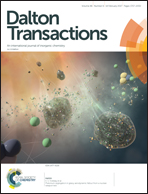Three novel and various isopolymolybdate-based hybrids built from the carboxyl oxygen atoms of in situ ligands: substituent-tuned assembly, architectures and properties†
Abstract
By changing the N-donor groups of benzonitrile-based reactants, three novel isopolymolybdate-based compounds, [CuII3(DBIBA)3][δ-HMo8O26] (1), [CuII2(H2O)(DIBA)(DIBAH)(γ-HMo8O26)]·2H2O (2), and [CuI(DTBA)(Mo2O6)] (3) (HDBIBA = 3,5-di(benzoimidazol-1-yl)benzoic acid, HDIBA = 3,5-di(1H-imidazol-1-yl)benzoic acid and HDTBA = 3,5-di(1,2,4-triazol-1-yl)benzoic acid) were synthesized, in which the benzene carboxylate-based ligands DBIBA, DIBA and DTBA were in situ transformed from the benzonitrile-based ligands under hydrothermal conditions. Selecting benzoimidazol as the N-donor group, compound 1 with a 3D (6, 8)-connected framework is constructed from {Cu3(DBIBA)3} hexagonal ring building units and [δ-Mo8O26]4− polyoxoanions. Replacing the benzoimidazol with the imidazol group, a 3D (3, 4, 6)-connected framework 2 containing two types of {(γ-Mo8O26)(DIBA)2} building blocks was obtained. When the triazol groups are introduced, compound 3 displays a 3D framework, which is constructed from {(Mo4O13)(DTBA)2}n chains bridged by CuI atoms. It is interesting to note that the carboxyl oxygen atoms from the in situ ligands participate in the construction of isopolymolybdates in compounds 2 and 3. In addition, the various N-donor groups of in situ ligands show a great effect on the oxidation state of copper ions, the novel polymolybdate unit and the final architectures of the title compounds. The electrochemical properties and photocatalytic activities of compounds 1–3 were investigated herein.



 Please wait while we load your content...
Please wait while we load your content...